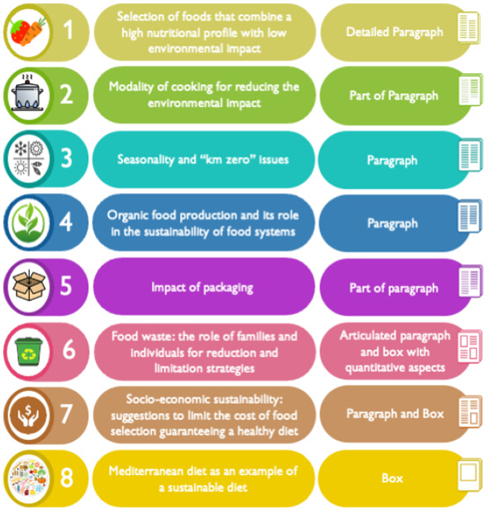Topic/Category
Year
Topic/Category
Year
30 January 2024
Diet composition and food quality have direct effects on human health; however, the indirect health effects caused by environmental change associated with the processes of producing food are less recognised. As national dietary guidelines provide advice for a healthy diet, they must consider both direct and indirect health consequences of nutritional recommendations. This is of particular relevance as the Australian Dietary Guidelines are currently under review.
The key objective of this paper was to describe the process of the inclusion of sustainability in the Italian Dietary Guidelines (IDGs). The IDGs’ sustainability chapter’s objective (see Figure 1 – Directive 13) was the fostering of food choices aimed to promote both human health and environmental protection. The IDGs’ sustainability recommendations were related to 16 guiding principles of a sustainable healthy diet and their contribution to the achievement of the Sustainable Developing Goals was provided.
Emphasis was put on the selection of foods, recommending a plant-based diet with a large quota of vegetable proteins. Advice was also given on the selection of local seasonal products with low growth input requirements such as fertilizers, artificial light and heating. Reduction of animal food (such as processed meat and red meat) was recommended, to be substituted with lower impact foods (such as poultry, milk, eggs and fish). Regarding fish, the advice is to include a diet of small Mediterranean fish including aquaculture such as anchovies, sardines, and mackerel, reduce consumption of the generally preferred species such as tuna, salmon, swordfish, that are subject to overfishing.
Food waste was also largely addressed. Recommendations were made for food purchase planning, food storage and the reuse of leftovers as strategies to reduce waste and save money. A list of “myths” and false beliefs was reported at the end of directive 13 to demonstrate that people’s erroneous beliefs could also be addressed in the communication framework.
A limitation of the development of sustainability recommendations was that it was carried out without an evaluation of Italian consumers’ awareness of sustainability. Another limitation was related to the commission that included nutrition experts with an under-representation of environmental sustainability competencies. Lastly, as with many nations’ dietary guidelines, there is an existing gap between dietary recommendations and actual consumer behaviour, indicating a generally poor compliance with the IDGs.
The inclusion of sustainability in dietary guidelines requires a multidisciplinary approach to cover the wide range of aspects of a sustainable diet. In the IDGs, it was possible to show that practical recommendations for improving sustainability behaviour can be passed on to consumers. However, the methodological aspects for developing recommendations are not definitive.

Rossi L, Ferrari M, Ghiselli A. The Alignment of Recommendations of Dietary Guidelines with Sustainability Aspects: Lessons Learned from Italy’s Example and Proposals for Future Development. Nutrients. 2023; 15(3):542. https://doi.org/10.3390/nu15030542